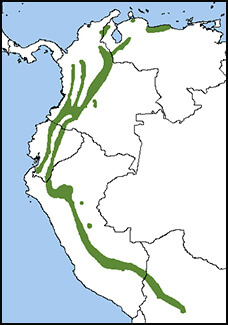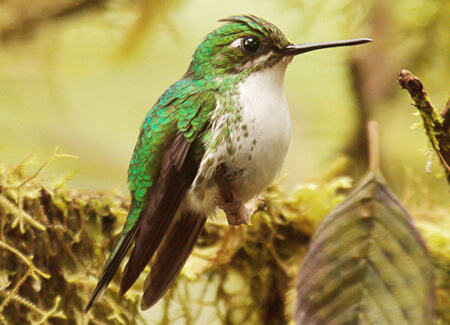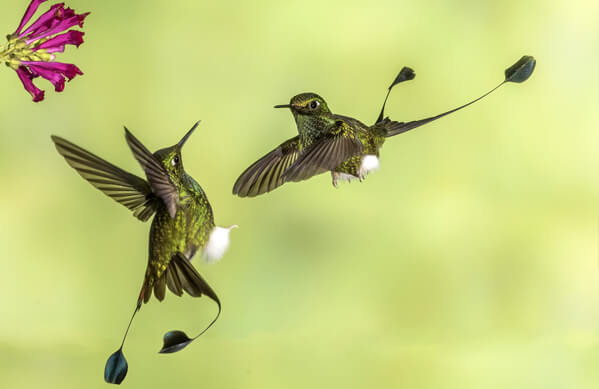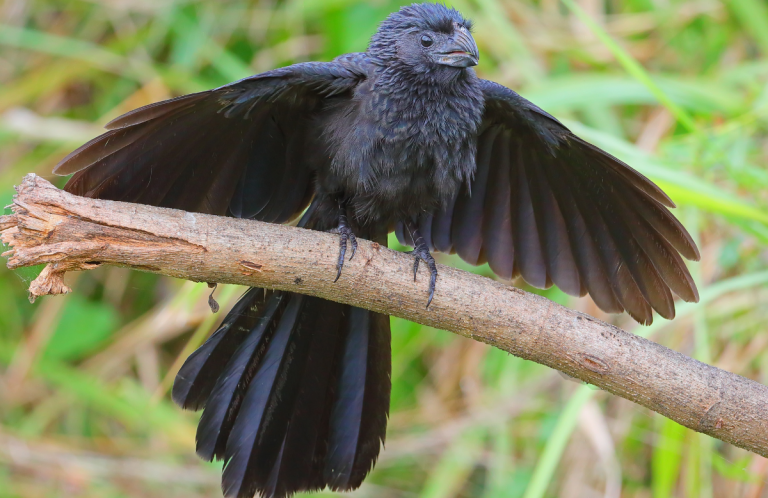 The male Booted Racket-tail is a spectacular hummingbird with metallic green plumage and an elaborate tail longer than the tiny bird itself! This streamer-like tail, similar to the Marvelous Spatuletail's, features two elongated feathers tipped with blunt bluish "rackets." Females lack the long tail, but both sexes wear “boots” (puffy white leg feathers).
The male Booted Racket-tail is a spectacular hummingbird with metallic green plumage and an elaborate tail longer than the tiny bird itself! This streamer-like tail, similar to the Marvelous Spatuletail's, features two elongated feathers tipped with blunt bluish "rackets." Females lack the long tail, but both sexes wear “boots” (puffy white leg feathers).
The Booted Racket-tail is the only member of its genus, but it's closely related to the puffleg, several of which are critically endangered due to habitat loss.
This hummingbird is an Andean mountain specialty, found in mid-elevation woodlands from Colombia and Venezuela south to Bolivia. Three subspecies are recognized, with either white or rufous boots. Males of different subspecies show variable tail length and racket colors. These plumage differences may eventually lead to this hummingbird being split into several species.
Leg Puffs and Streamer Claps
Male Booted Racket-tails establish feeding territories and aggressively chase away other males as well as large insects—such as bumblebees and hawk moths—that try to feed in their territory. With aerial flights and intimidating displays, they attempt to chase away any intruders.
Males attract females by displaying their leg puffs and clapping their tail streamers together during steep U-shaped dives. Both genders may mate with several partners.
As with other hummingbirds from the Ruby-throated Hummingbird to the Glittering Starfrontlet, the female takes care of all duties related to caring for the young. She builds a cup-shaped nest of plant fibers and down covered in moss and lichen, usually positioned 20 to 30 feet high in a tree, where she lays two or three tiny eggs. She may raise several broods per year if food supplies are sufficient.
Sign up for ABC's eNews to learn how you can help protect birds

Female Booted Racket-tail, Kevin Heffernan
Protein for Pufflegs
In addition to nectar, Booted Racket-tails and other hummingbirds also take small spiders and insects, an important source of protein for development of the chicks. The birds often catch insects in flight, a behavior called hawking; they also snatch them from leaves or branches, and pluck them from spider webs. A nesting female can capture several thousand insects a day.
This species is not a long-distance migrant but does show some altitudinal migration after the breeding season, moving to higher or lower elevations to take advantage of the best flowering plants.
Where to See the Booted Racket-tail
Booted Racket-tails readily come to nectar feeders and may be seen at 13 reserves supported by ABC and our in-country partners, including Colombia's Tanagers Reserve, Ecuador's Tapichalaca and Buenaventura Reserves, and Peru's Abra Patricia Reserve.
Although the Booted Racket-tail and most other puffleg species remain fairly common, three—the Colorful Puffleg, Black-breasted Puffleg, and Gorgeted Puffleg—are critically endangered. One, the Turquoise-throated Puffleg, is possibly extinct and is the focus of a “Lost Birds” expedition supported by ABC to relocate it.
Donate to support ABC's conservation mission!



















































